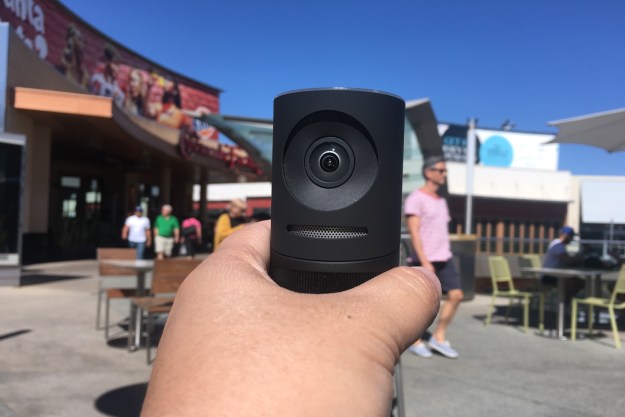
“The Mevo Plus is like having a broadcast camera crew in your pocket.”
- 4K and 1080p recording
- Improved performance
- Stable
- Android and iOS support
- Live zoom-and-pan editing
- Short battery life
- 4K streaming not supported
The Mevo camera was the first (that we’re aware of) that’s designed specifically for Facebook Live. It’s easy to use, and let’s you create live broadcasts on Facebook in a few taps. Even better, it lets you edit while recording live, allowing you to zoom and pan around the frame by simply tapping, pinching, or sliding on the screen of a paired smartphone. Although we liked it, we felt it was a bit of a pricey novelty that had issues and limitations. And since the Mevo’s launch, several cameras and phones have jumped on the Facebook Live bandwagon.
Enter the Mevo Plus, an improved camera from Livestream that addresses those issues and limitations. You could call it the camera we wished the original had been. It’s faster and stronger, and more stable, yet it retains the ease-of-use of the original, including the zoom-and-pan functions we liked. It also now records in 4K and 1080p, works with Android, and supports more live-stream platforms other than Facebook Live, including YouTube and Periscope/Twitter. And from the first impressions in our Livestream Mevo Plus review, it’s a better product. It’s still pricey, and it’s still niche, but the improvements make it a more compelling reason to add it to your camera arsenal, especially if you do a lot of live broadcasts on the internet.
The Mevo Plus is on sale now, for $500. The first-generation Mevo is being phased out of the retail channel, but you can still get one for $300, while supplies last.
Same look, but reengineered
The original Mevo was well designed, so we don’t have major qualms about Livestream repurposing the same look and feel. The only observable difference is a switch from a red grille to a gray color, covering the speaker and stereo mics.
The big changes are inside, and they affect performance. New are 2×2 MIMO antennas that offer improved data transmission speeds. A new 802.11ac Wi-Fi chip also increases performance and range. You can also stand farther from the camera when operating it remotely. And if you’re handholding the camera for action shots, there’s now electronic image stabilization, although like most cameras with EIS, it requires cropping into the image.
It’s still pricey, and it’s still niche, but improvements make the Mevo Plus compelling.
As for the main guts, the Mevo Plus is the same as the original. It uses a 150-degree glass lens and 12-megapixel Sony
Another nice update is support for
The Mevo Plus works with the existing Boost accessory that increases battery life by up to 10 times. It also has Ethernet and standard USB jacks for more stable connectivity, ideal for broadcasting important live events where you can’t rely on Wi-Fi or LTE. The USB port also works for recharging the battery or attaching a better microphone. It’s a pricey accessory, at $250, but necessary if your job depends on equipment reliability.
Performance and use: first impressions
The Mevo Plus and the Mevo app work exactly the same as the first-generation Mevo, so you can read about our thoughts in our review. In a nutshell, the Mevo Plus is a portable, live-broadcasting camera that gives independent producers the features that you would get with a camera crew. With a paired smartphone or tablet, you can shoot a wide scene, zoom in quickly by tapping on any part of the frame, or create smooth zooms or pans by pinching or sliding — you get to play director and cameraman. There are still the adjustable picture settings in the app, and the face-tracking feature that automatically follows a subject.
Our favorite thing about the Mevo Plus, so far, is the improved performance, from start to finish. Although it employs the same pairing and operation processes as the first-generation Mevo, the Mevo Plus just does it better. We haven’t encountered any pairing issues, nor have we suffered dropped connections — things we had to deal with in the first model. Wi-Fi just seems more robust, and we were also able to live-stream to
Our favorite thing about the Mevo Plus, so far, is the improved performance
Image stabilization is nice to have, but we see the camera more as a stationary product that an action cam. Still, we are sure there will be creatives who want to attach it to a moving object, or those who want to physically move around the room than using the virtual zoom and pan.
We love that it can record in
The other noticeable issues are no fault of the Mevo Plus, but more with the live-streaming platforms.
We’re also not thrilled that battery life is still short. It’s rated for up to one hour, the same as the original. This was a complaint we had in our Mevo review, and we think it will be the same complaint we will have in our full review of the Mevo Plus.
The camera for indie live-broadcasting
These features were teased earlier this year at the 2017 NAB show, and the Mevo Plus is essentially the final product that Livestream promised we would see by the end of summer (you can also add some of these features to the original Mevo, via firmware update). While it is an evolutionary product versus something completely new, it addresses most of the main cons we had with the original, particularly improved connectivity and the ability to record in higher resolutions.
As a general consumer product, it’s pricey at $500, especially considering that you can create live broadcasts with your phone, albeit minus the zoom-and-pan functions. But for YouTube creatives, event producers on a budget, wedding photographers who want to offer more value to their services, or
We will have a final review after we complete our tests. Stay tuned.







